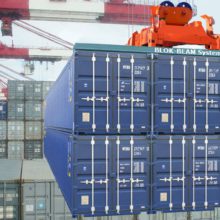
At a demonstration event at Singamas QSOE the revolutionary Ship to Shore Crane showed how the system blocks containers together and revealed how to start immediately making these savings compliant with IMO and OSHA
The ‘BLOK-BEAM’ system was invented by Martin Clive Smith and John Evans to speed loading empty ISO freight containers onto container ships.
In 2012 ‘The World Shipping Council’ estimate the equivalent of over14 million twenty foot containers were returned empty from Europe and North America back to the Far East because there was no cargo for the return journey ‘The Empty Leg’. This imbalance continues to the present day.
Normally containers are lifted one or two at a time by ‘Gantry Cranes, fitted with automatic spreaders. BLOK-BEAM consolidates empty containers into a single unit of six or more containers (a BLOK) ready for lifting as a one unit.
BLOKs are assembled two containers high ‘off quay’ by teams of Stevedores using a combined positioning jig / ‘MAFI’ trailer called an ‘OX’. Assembly is complete when two steel ‘BLOK-BEAM’s’ are secured over the BLOK’s front and rear ends. BLOCKs can then be towed by an OX to the quayside – one journey instead of six – ready for lifting by crane.
The tare weight of a 20ft container is approximately 2 ton, a 40ft around 4 ton. Most terminal cranes can lift a loaded 40ft container (34 ton) and 40 ton when they lift hatch overs. Two 40fts or four 20fts can be lifted with twin-Lift spreaders, but in many terminals containers are lifted on and off ships one at a time.
BLOKs can be assembled ahead of time, providing a balanced work load which avoids Stevedores having to work extended shifts, or unsocial hours. With BLOK-BEAM it is possible to raise lifting rates from a present average of 30 containers per hour, to over 180 per hour, an astounding increase in productivity.
To cut ship loading times empty containers are assembled ready for lifting into ‘BLOKs’ of six, (three containers wide and two high). For stability containers are cross linked using patented ‘Star Locks’. Fastening two ‘BLOK-BEAMS’ over the front and rear ends completes assembly. The whole BLOK is then ready to be lifted as a single unit, by existing terminal cranes.
During assembly the details of each container is recorded, including its number, size, type, tare weight and date of manufacture. All containers must have a valid CSC plate. During loading, containers are inspected for damage with particular attention paid to the front and rear end frames.
The BLOK-BEAM System allows all existing STS Cranes to lift empty containers at speeds of 180 containers per hour.